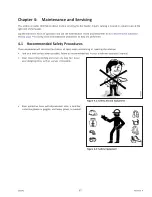
262391
61
Revision A
A wider windrow will generally dry faster and more evenly, resulting in less protein loss. Fast drying is especially important
in areas where the weather allows only a few days to cut and bale. A narrower windrow may be preferable for ease of
pick-up and when drying is not critical (for example, when cutting for silage or green feed).
Positioning Forming Shield Side Deflectors
–
Roll Conditioner
The position of the side deflectors controls the width and placement of the windrow. To ensure that windrow placement is
centered between the tractor wheels, adjust the left and right deflectors to the same position.
DANGER
To prevent bodily injury or death from the unexpected startup of the machine, always stop the engine and remove the
key from the ignition before leaving the operator
’
s seat.
1.
Shut down the engine, and remove the key from the ignition.
ϭϬϰϯϲϵϲ
A
B
C
Figure 3.55: Side Deflector and Adjuster Bar
2.
Loosen locking handle (A).
3.
Slide adjuster bar (B) along adjuster plate (C) to the desired
deflector position and engage bar (B) into a notch in the
adjuster plate.
4.
Tighten locking handle (A).
5.
Repeat the adjustment on the opposite side.
Adjusting Conditioner Baffle Position
The conditioner baffle is used in conjunction with the side deflectors to determine the height and width of the windrow.
The conditioner baffle is located immediately behind and above the conditioner rolls and can be positioned to do the
following:
•
Raise the baffle and direct crop flow into the forming shields for a fluffier, narrower windrow.
•
Lower the baffle and direct crop downward to form a flatter, wider windrow.
To adjust the conditioner baffle position, follow these steps:
DANGER
To prevent injury or death from the unexpected start-up of the machine, always stop the engine and remove the key
from the ignition before leaving the operator
’
s seat for any reason.
1.
Shut down the engine, and remove the key from the ignition.
















































